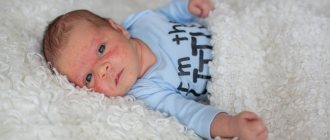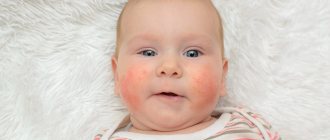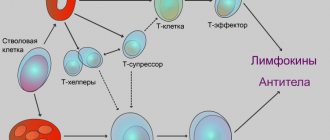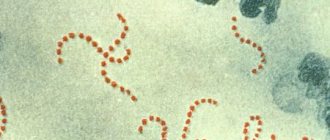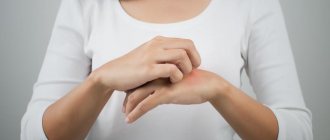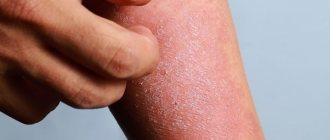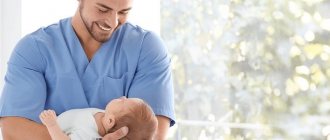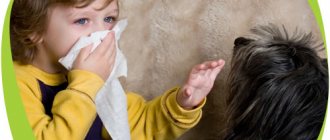Clinical manifestations of rosacea
The disease begins after 25-30 years. First, there is a tendency to frequent redness of the face, less often the neck and décolleté. “Burst blood vessels” (telangiectasias) appear. Then the redness in some areas becomes persistent. Subsequently, inflammation, peeling, and rashes (outwardly resembling pimples) may develop at the site of persistent redness. Without treatment, the number of such elements increases. Dryness and redness of the eyes often develop. In a small proportion of patients, with age, the so-called rhinophyma develops, a thickening and growth of the skin of the nose (“bumpy nose”).
Types of rosacea: A - Erythematotelangiectatic rosacea, B - papulopustular rosacea, C - rhinophyma, D - ocular rosacea. Photo: Dermatology Reports / Open-i (CC BY-NC 3.0)
The cause of rosacea is impaired vascular tone of the face and inflammation in the vascular wall. They can be caused by various factors: hormonal disorders, characteristics of psycho-emotional status, diseases of the cardiovascular or digestive system, microbial factors. A doctor must understand the possible causes of the development of rosacea in a particular person and analyze the degree of influence of a particular health feature. The main task is to minimize external and internal factors that aggravate rosacea, and to directly affect the blood vessels of the face. Treatment regimens are chosen by the doctor; they are strictly individual in nature.
Photo: Dermatology and Therapy / Open-i
Diathesis, red cheeks - atopic dermatitis?
When children come to the appointment with red cheeks, red spots with peeling on the arms and legs, manifestations of atopic dermatitis, parents often do not know why their child has such problems.
Most often, mothers in such cases associate the manifestations of dermatitis with “Moscow water”, which “does not suit” them.
However, it must be recognized that food allergies most often occur in infants and, in the vast majority of cases, the culprit is cow's milk, or rather, cow's milk proteins.
If a child receives artificial nutrition, then the basis of such mixtures is cow's milk proteins (whey and casein protein fractions). Thus, when receiving formula milk, the child receives a large amount of the corresponding allergen.
If a child is breastfed, cow's milk proteins enter the child's body through breast milk.
Studies have shown that 95% of women have beta-lactoglobulin in their breast milk - one of the most allergenic proteins in cow's milk.
However, it must be emphasized that breastfed (naturally) fed children suffer from food allergies much less frequently, which is due, among other things, to the lower content of such components in breast milk.
The basis of treatment for manifestations of food allergies and intolerance to cow's milk proteins is the selection of proper nutrition.
When a child is breastfed and there are symptoms of intolerance to cow's milk proteins, the mother is often advised to adhere to a strict dairy-free diet, when all dairy products are excluded from the diet, including cheese, kefir, cottage cheese, etc., and not just whole milk, as is sometimes thought. Since such dietary recommendations are quite difficult to follow, especially for us, residents of the middle zone, where the culture of dairy nutrition is widespread, it is very important that these prescriptions have a real basis.
However, it must be admitted that there is an improvement in the condition of the child’s skin and the functioning of his digestive tract with proper nutrition correction. This is where even such a term as “diet diagnosis” came from, i.e., when, after excluding certain foods, we see a positive result, which confirms the diagnosis, and “diet therapy,” when continuing to follow the recommendations for appropriate nutrition, it is possible to achieve good therapeutic effect.
One of the frequently asked questions from parents is: “Is it possible to switch a child with intolerance to cow’s milk proteins to goat’s milk?”
The answer is not entirely reassuring. In the vast majority of children, when trying to replace a cow's milk-based formula with a "goat" formula, it is not possible to achieve remission and subsidence of the symptoms of the disease.
For rational nutrition of bottle-fed children with allergies to cow's milk proteins, specialized therapeutic nutrition based on hydrolyzed (split) components is used. In such mixtures, the protein is divided into smaller components, down to the smallest particles - amino acids. Such therapeutic nutrition should be selected by a pediatrician in close cooperation with an allergist-immunologist.
Another important aspect of the treatment of atopic dermatitis is external therapy. And in this case, it is necessary to start with basic, long-term moisturizing of the skin with specialized products - emollients.
Therapy for atopic dermatitis is carried out in stages, i.e. According to the severity of the disease, the “severity” of the drug effect is selected. In other words, we move from simple to complex, from skin moisturizers to preparations containing anti-inflammatory drugs, hormones, and, if necessary, antibiotics, etc.
Fortunately, usually by the age of 2-3 years, allergies to cow’s milk proteins recede into the background, and in 80% of cases, by the age of 5, children develop tolerance (immunity) to this product.
However, the calmer the child’s early childhood period is, the higher the chances of not moving to a new stage of allergic processes and maintaining health for many years.
Therefore, it is very important, if you suspect allergopathology, to look for the correct cause of this condition, and adhere to a healthy lifestyle and the principles of rational nutrition.
Pediatrician, allergist-immunologist, chief physician of the Sanare clinic Yulia Mikhailovna Marinina
What happens in the skin?
Redness, no matter what causes it, represents increased blood flow to the skin. The vessels dilate greatly and contract with difficulty. Some of the fluid from the overcrowded vessels can seep into the surrounding tissues - swelling occurs.
Proteins and blood cells may also leak out. The condition of connective tissue fibers and muscles that help blood vessels contract and drain blood and lymph from the skin deteriorates. Stagnation and low-grade inflammation occurs in and around the vascular wall. Opportunistic and pathogenic microorganisms can join this inflammation, which weakens the skin’s defenses.
Rosacea treatment
Treatment of rosacea using intense pulsed light (IPL) technology.
Photo: BioMed research international / Open-i (CC BY 3.0) Therapy for this disease depends on the totality of manifestations and characteristics of a particular person. There is a classic treatment regimen for rosacea, accepted in dermatology. These are antibiotics, metronidazole, retinoids, antihistamines, local therapy.
Creams, gels, ointments containing azelaic acid, metronidazole, retinoids, pimecrolimus, and antibiotics are used topically. Treatment lasts several months. As prescribed by a doctor, various combinations of medications and their alternation can be used. Historically, ointments and pastes with ichthyol, tar, sulfur, and salicylic acid were widely used. Often they are still used today due to their low price, but all these products irritate the skin.
The main treatment should be aimed at eliminating provoking factors and restoring the normal state of blood vessels. Triggers vary from person to person, but the clear leader is excessive emotional reactions.
Physiotherapy has all these qualities.
The first stage of therapy, the longest, is to reduce swelling and inflammation in and around the vascular wall. Two methods are suitable for this. Laser-magnetic therapy is a combination of red and infrared laser radiation with a constant magnetic field. A powerful anti-edematous and anti-inflammatory effect on the vascular wall promotes the outflow of excess blood and lymph from the face.
Mens therapy, better known as microcurrent . A mild anti-inflammatory effect, restoration of normal tone of the neuromuscular system that regulates vascular contraction, normalizes vascular reactions to external influences.
Both procedures are prescribed 2 times a week, a total of at least 12-20 procedures are required. Depending on the prevalence of specific symptoms, you can start with microcurrent (redness and hot flashes predominate) or laser-magnetic therapy (swelling and inflammation predominate). For optimal results, it is advisable to use both methods. The procedures are inexpensive and painless, but require regular visits to the doctor (2 times a week for 30-40 minutes). The earlier treatment is started, the more effective and shorter it will last. After the procedures, maintenance therapy is prescribed.
In addition to physical therapy, medications may be prescribed that are selected individually. Efficacy is assessed as treatment progresses; drugs may be changed or combined.
Second phase. After stabilization of the situation, persistently dilated vessels that cannot be eliminated by therapeutic methods are removed.
One of the most effective and gentle methods for removing “vessels” is the use of a neodymium laser with a short powerful pulse. Delivery of such a pulse with an absorption spectrum in oxyhemoglobin (a blood component) promotes the removal of blood vessels without damaging the surrounding tissue.
Red spots under the eyes (around the eyes)
Our skin is one of the first to react to any negative changes in the body. The more sensitive the skin, the faster and brighter the signs of any disease appear on it. The thinnest layer of skin is located in the area around the eyes. As a rule, the skin in this area is uniform in color, one tone lighter or darker than the base color of the facial skin. But sometimes red spots appear under or around the eyes, which can signal a number of diseases of the visual organs or the entire body as a whole.
Causes of red spots under the eyes
Various factors can cause the appearance of red spots around the eyes, including:
- Stress, lack of sleep and nervous tension. When the daily routine is normalized and the emotional state is restored, the redness disappears
- Dermatological problems. For example, with eczema and dermatitis, the skin around the eyes not only turns red, but also flakes and may also become crusty.
- Kidney diseases - stones, kidney failure and other pathologies make themselves felt by the appearance of bags, swelling, as well as redness or darkening under the eyes
- Inflammatory processes - abscesses and phlegmon (purulent inflammation). In such cases, redness is accompanied by increased body temperature.
- An allergic reaction in which in addition to redness there is also itching
- Vitamin deficiency and unhealthy lifestyle: lack of exercise, lack of air, poor diet and bad habits often contribute to the deterioration of skin condition
- Congenital skin abnormalities.
Do not forget that only a specialized specialist can establish the true cause of the disease and help get rid of unpleasant symptoms.
Differences between rosacea and rosacea
Cuperosis.
Photo: evgeniasheidt / freepik.com Cuperosis is the appearance of “bursted” blood vessels (telangiectasia) on the face and body. This may be the initial manifestation of rosacea or an independent disease. The difference from rosacea is that there is no progression in the form of inflammation and the appearance of rash elements. The concern is not so much the persistent diffuse redness as the presence of “vessels”. If rosacea is mild, manifested by single vessels, then treatment is limited to their removal. If the presence of “vessels” is accompanied by “hot flashes” to the face, heaviness and swelling in the legs, etc., you should consult a doctor to have a consultation and find out whether there are signs of rosacea or, if the “vessels” are located on the legs, varicose veins.
The editors thank the specialists of the BioMI Vita clinic for their assistance in preparing the material.
Solving the problem yourself
Temporary, or transient, redness of the facial skin is not considered a pathology. It disappears on its own and does not cause much discomfort other than psychological. To remove occasional cases of hyperemia on your own, you should follow simple steps:
- Remove the irritating factor
. Change the environment, wash off the allergen or toxic substance from the surface of the skin, try to calm down. - Restore natural skin color
. Folk remedies and herbal remedies help with this. You must first make sure that you are not allergic to the components. - Take care to strengthen the protective barrier
. To do this, it is advisable to carry out a set of measures aimed at improving the health of the body as a whole and maintaining the functional properties of the skin.
The following recommendations can also help get rid of a red face, but will require a long time and lifestyle adjustments.
Gentle cleansing and care.
You should wash your face with warm water, without contrasting temperatures, and dry with a soft towel with light blotting movements.
Prevention of infections.
An important rule is to never touch your face with your hands unnecessarily. The habit of removing pimples yourself can lead to infection not only local, but also general. Even with minor damage and scratches, it is worth immediately treating the area of microtrauma with an aseptic substance.
Lifestyle.
The diet must contain foods rich in fiber and vitamins.
It is worth avoiding the consumption of salty foods, smoked meats, spicy seasonings and alcohol. Good sleep and a calm microclimate also help remove redness on the face. Caring cosmetics.
The beauty industry provides a wide range of cleansing, lipid-restoring and healing products. It can be difficult to understand them on your own, however, dermatologists recommend not to get carried away with cosmetics based on alcohol solutions and to carefully choose them. Individual consultation
